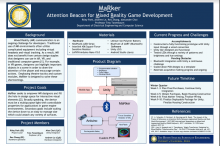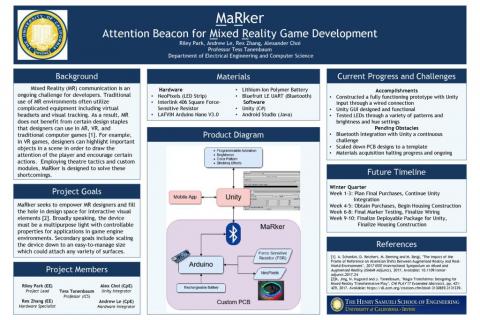MaRker: Attention Beacon for Mixed Reality Game Development
With the emergence of the MR (Mixed Reality) concept in the 1990’s, MR has been subject of intense research. One outcome of this research is the realization that MR environments can be used in the development of games for the purpose of enhancing gameplay experiences. These approaches, however, often center around the use of AR (Augmented Reality) headsets which convey visual information directly from the virtual environment to the physical. An alternate method of conveying information is the usage of theatre practices to guide participants in the MR environment through the experience. By utilizing physical props embedded with wearable IoT (Internet-of-Things) devices and vocal guidance such as backleading for subjects to interact with a virtual environment, researchers can develop new methodology for MR gameplay.
One major hurdle of non-visualized MR experiences is successfully conveying information between the virtual and physical environments. To remedy this problem, game designers and developers typically utilize equipment such as visual sensors, RFID trackers, visual indicators, etc. to guide players within the experience. This approach has several shortcomings: One, designers often have a limited understanding of the environment state during gameplay due to a lack of instantaneous player feedback. For example, a designer may or may not know whether a player is holding an object without direct supervision. Two, activities which are considered illegal within the game can be poorly monitored. Finally, many elements in the virtual environment must be manually updated by the designer for further utilization in the scenario.
Our team, Team Lights and Action, intends to develop multipurpose devices, called MaRkers (Mixed Reality), that addresses the shortcomings previously listed, under the primary supervision of our faculty mentor, ICS Professor Tess Tanenbaum, and administratively controlled by the EECS Senior Design course headed by Professor Stuart Kleinfelder. Within two academic quarters, our team, consisting of four EECS undergraduate students of mixed disciplines, will construct and test MaRkers that will be attachable to any wearable or holdable object that a mixed reality game developer will wish to monitor or indicate towards in a wireless manner. Each MaRker module will possess sensors and lighting indicators controlled by a lightweight microcontroller for integration with Unity, a powerful game engine for development in mixed reality.
The purpose of this project is to design, create, and test a device to improve communication in mixed reality environments for use in mixed reality game design. By doing so, the undergraduate students will gain valuable knowledge and insight engineering devices utilizing both software and hardware design principles, as well as a broader awareness and understanding of emerging technologies in mixed reality game development. Each student will gain in-depth experience with modern hardware and software tools available in the IoT industry.


